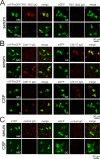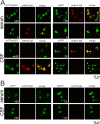Epitope specificity of anti-synapsin autoantibodies: Differential targeting of synapsin I domains
- PMID: 30543686
- PMCID: PMC6292584
- DOI: 10.1371/journal.pone.0208636
Epitope specificity of anti-synapsin autoantibodies: Differential targeting of synapsin I domains
Abstract
Objective: To identify the specific domains of the presynaptic protein synapsin targeted by recently described autoantibodies to synapsin.
Methods: Sera of 20 and CSF of two patients with different psychiatric and neurological disorders previously tested positive for immunoglobulin (Ig)G antibodies to full-length synapsin were screened for IgG against synapsin I domains using HEK293 cells transfected with constructs encoding different domains of rat synapsin Ia. Additionally, IgG subclasses were determined using full-length synapsin Ia. Serum and CSF from one patient were also screened for IgA autoantibodies to synapsin I domains. Sera from nine and CSF from two healthy subjects were analyzed as controls.
Results: IgG in serum from 12 of 20 IgG synapsin full-length positive patients, but from none of the healthy controls, bound to synapsin domains. Of these 12 sera, six bound to the A domain, five to the D domain, and one to the B- (and possibly A-), D-, and E-domains of synapsin I. IgG antibodies to the D-domain were also detected in one of the CSF samples. Determination of IgG subclasses detected IgG1 in two sera and one CSF, IgG2 in none of the samples, IgG3 in two sera, and IgG4 in eight sera. One patient known to be positive for IgA antibodies to full-length synapsin had IgA antibodies to the D-domain in serum and CSF.
Conclusions: Anti-synapsin autoantibodies preferentially bind to either the A- or the D-domain of synapsin I.
Conflict of interest statement
The authors have declared that no competing interests exist.
Figures




References
-
- Piepgras J., Höltje M., Otto C., Harms H., Satapathy A., Cesca F., et al. Intrathecal immunoglobulin A and G antibodies to synapsin in a patient with limbic encephalitis. Neurol Neuroimmunol Neuroinflamm. 2015. November 4;2(6):e169 10.1212/NXI.0000000000000169 - DOI - PMC - PubMed
-
- Höltje M., Mertens R., Kochova E., Brix Schou M., Saether S.G., Prüss H., et al. Synapsin-antibodies in psychiatric and neurological disorders: prevalence and clinical finding. Brain, Behaviour and Immunity 2017; July 18 pii: S0889-1591(17)30218-0. 10.1016/j.immuni.2017.05.003 - DOI - PubMed
-
- Fassio A., Patry L., Congia S., Onofri F., Piton A., Gauthier J., et al. Syn1 loss-of-function mutations in autism and partial epilepsy cause impaired synaptic function. Hum Mol Genet 2011; 20:2297–307. 10.1093/hmg/ddr122 - DOI - PubMed
-
- Baldelli P., Fassio A., Valtorta F., Benfenati F. Lack of synapsin I reduces the readily releasable pool of synaptic vesicles at central inhibitory synapses. Journal of Neuroscience 2007; 27:13520–13531. 10.1523/JNEUROSCI.3151-07.2007 - DOI - PMC - PubMed
-
- Bragina L., Candiracci C., Barbaresi P., Giovedì S., Benfenati F., Conti F. Heterogeneity of glutamatergic and GABAergic release machinery in cerebral cortex. Neuroscience 2007; 146:1829–1840. 10.1016/j.neuroscience.2007.02.060 - DOI - PubMed
Publication types
MeSH terms
Substances
LinkOut - more resources
Full Text Sources
Miscellaneous

